There are plenty of reasons to visit Florence, including its jaw-dropping beauty, its impressive history, and its world-class art, but for many people (read: us), a serious reason to continue visiting the Cradle of the Renaissance is that the food in Florence is simply divine.
With a long culinary history and a local cuisine primarily focused on simple, hearty, flavorful foods, traditional Tuscan food is famous around the world.
It’s no surprise, then, that the capital of Tuscany would be home to some incredible flavors–including many traditional Tuscan dishes that you may not have heard of before visiting (it’s not all pasta and wine!).
If you’re wondering what to eat in Florence–and how to identify the best spots–we wrote this Florence food guide for you.
Here are some of the best things to eat in Florence, plus tips on how to find them!
Table of Contents
- How to Try a Wide Variety of Florentine Foods At Once
- Delicious Things to Eat in Florence, Italy
- Types of Restaurants in Florence
-
Cool Experiences With Food in Florence
- Have breakfast the Italian way.
- Take a Tuscan cooking class.
- Shop at the Mercato Centrale or Mercato Sant’Ambrogio.
- Take a walking tour of the food in Florence.
- Have lunch at a panino shop.
- Settle in for a complete, multi-course Italian meal.
- Discover Florence’s wine windows.
- Experience wine tasting in Tuscany at a local winery.
- Read More About Food Culture in Italy
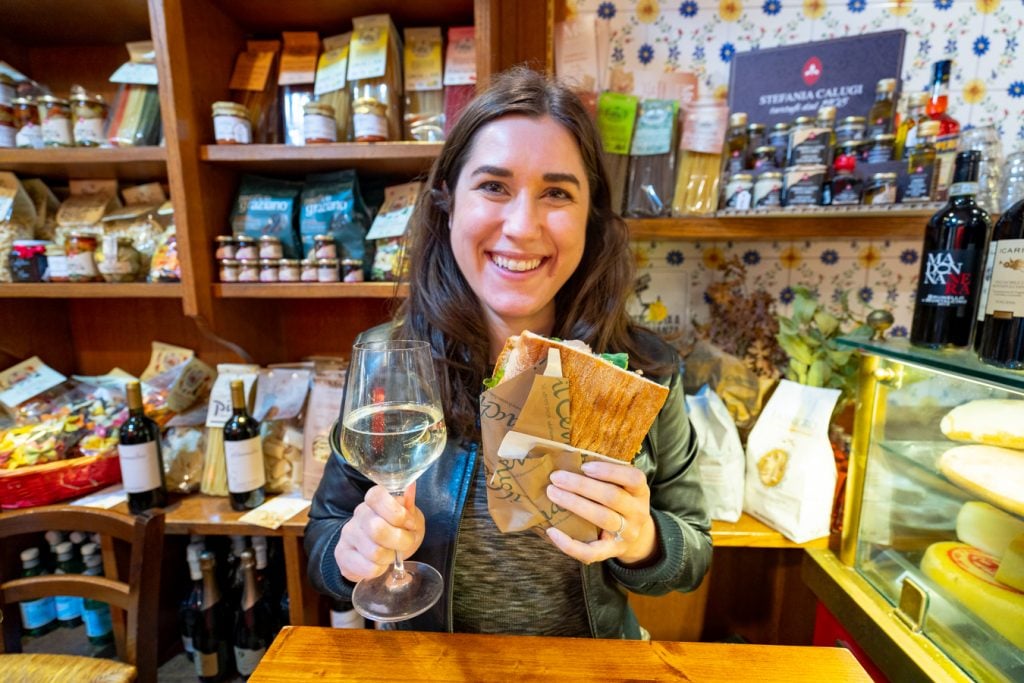
How to Try a Wide Variety of Florentine Foods At Once
Want to sample several of the best foods in Florence in one fell swoop, or simply want to be able to try small bites of each so you don’t accidentally order something you don’t like?
Consider signing up for this incredible Florence food tour that we loved!
We’ve enjoyed many food tours in Italy over the years (at least 6, not counting the cooking classes), and walk away every time feeling a bit more knowledgeable about both the local cuisine and whichever city we’re in as a whole.
Food tours allow you to sample far more dishes in one evening than you could try in a few days worth of “normal” eating!
If you would like to enjoy a food tour in Florence (or any other city), we recommend signing up for it as early in your trip as possible.
That way, you’ll have plenty of new favorite dishes to order in restaurants throughout the rest of your trip!
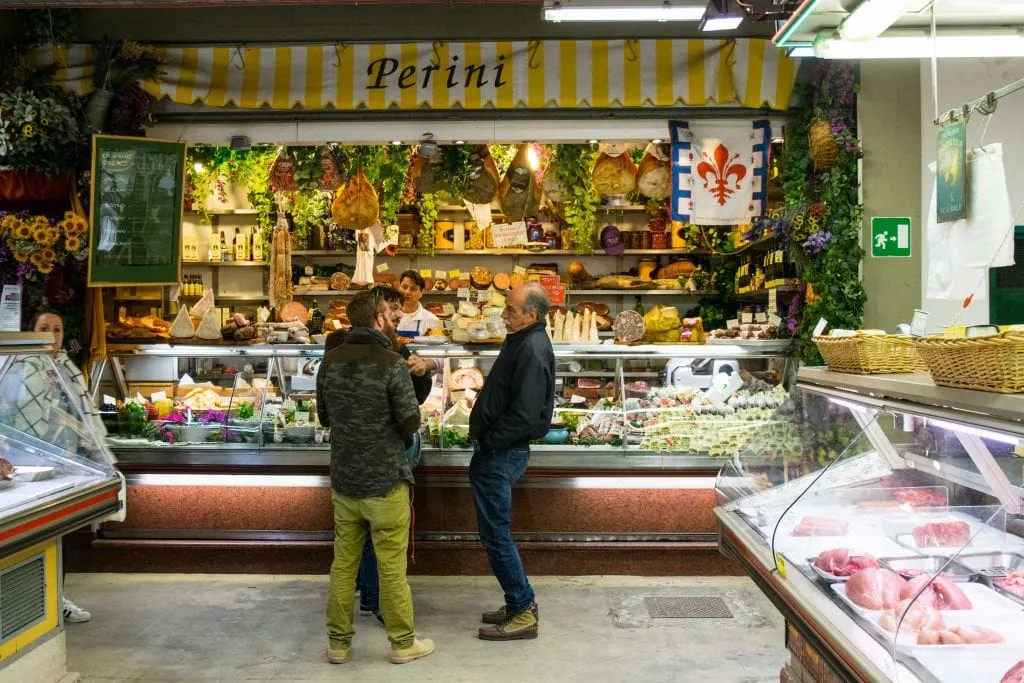
Delicious Things to Eat in Florence, Italy
Bistecca all Fiorentina
How could we start anywhere else?
One of Florence’s most famous dishes, Florentine steak is a specific cut of meat from part of the loin close to the leg, traditionally coming from female cows that have never given birth.
These steaks are enormous (ie, not to be consumed by only one person), and pricey for the area–they’re best reserved for a special night out.
Typically, Florentine steaks are sold by weight in restaurants.
They are tender, juicy, and very tasty, and a must-try dish when looking for the best food in Florence!
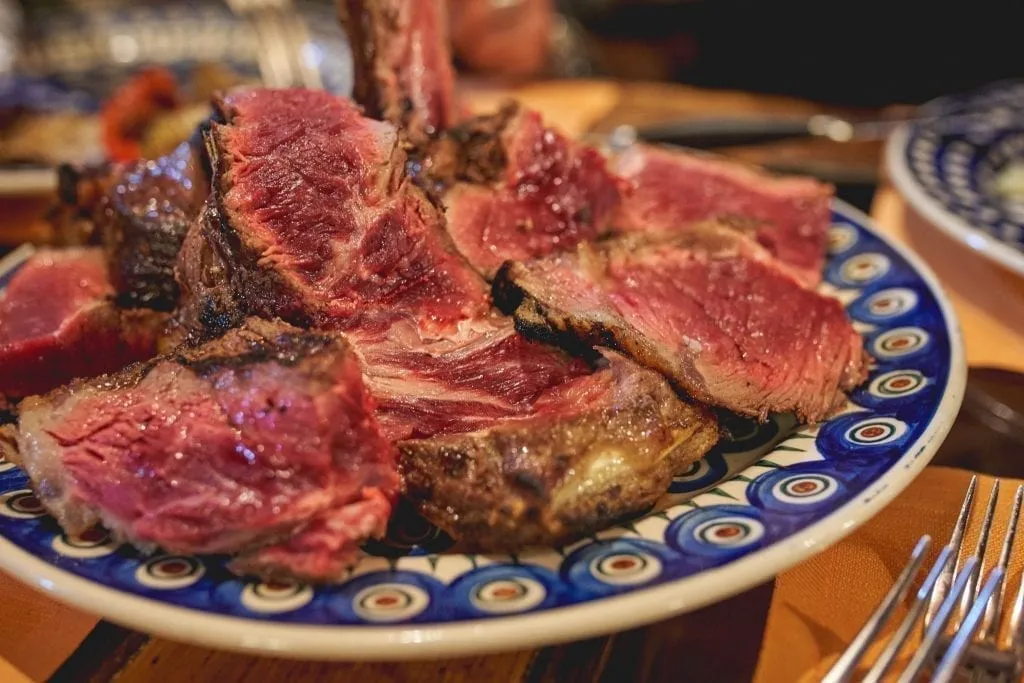
Fagioli con Salsicce
Beans with sausage is the epitome of rustic Tuscan cuisine!
It’s also a fabulous, reliable option if you’re trying to decide what to eat in Florence and want something simple and filling.
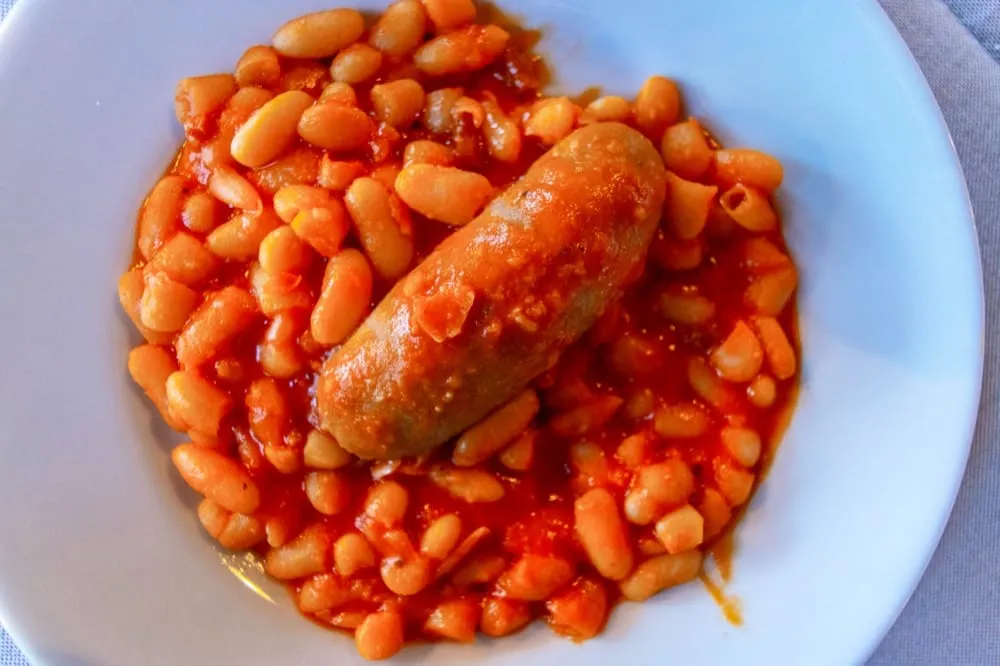
Olive Oil
I know, I know–olive oil is something to cook with or add to salad, it’s not a dish worth calling out on its own.
Typically true… but not in Tuscany.
Olive oil is not only plentiful and delicious here, but it’s also a cultural event.
Because fresher olive oil is considered to be better olive oil, the harvest of olives each fall creates a frenzy to obtain a fresh batch of extra virgin olive oil.
Ever since we happened to be in Tuscany during the olive harvest one year, we’ve been obsessed with extremely fresh olive oil and even planned trips around coinciding with the olive harvest again.
Much like wine, olive oil at its best isn’t a monolith–different batches can have enormously different flavors, and we’ve even enjoyed a couple of olive oil tastings in Tuscany at this point, including “flights” of different olive oils to compare and contrast.
There’s truly nothing like it, and we now consider it one of our favorite things to eat in Florence!
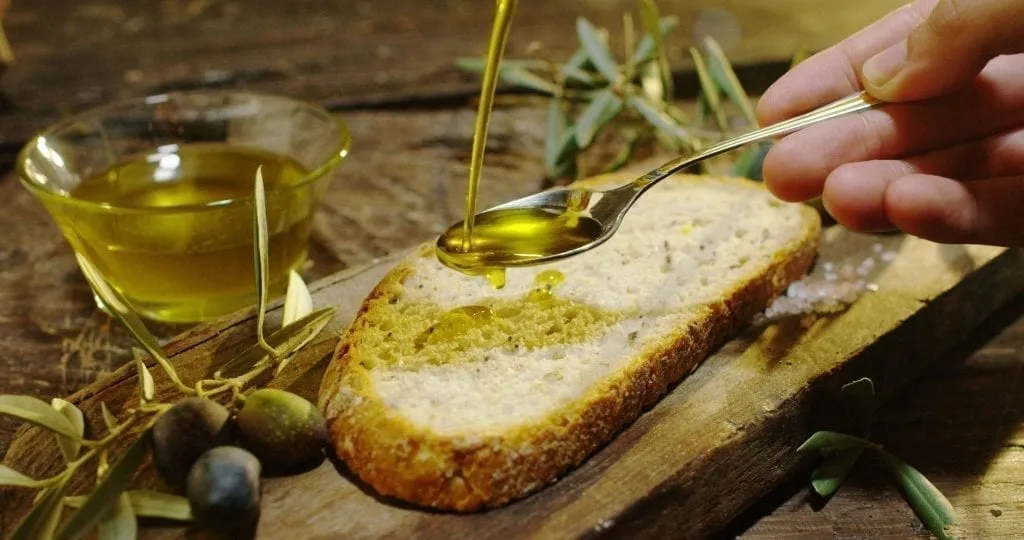
Fettunta
Is there anything better than classic fettunta (you may know it as bruschetta, its name in other parts of Italy)?
Technically, the most traditional fettunta doesn’t even require tomatoes or basil on top: Tuscan bread, garlic, salt, and (ideally fresh) olive oil are all you need.
That didn’t stop the chef at the cooking class we loved from jazzing it up with optional toppings, though!
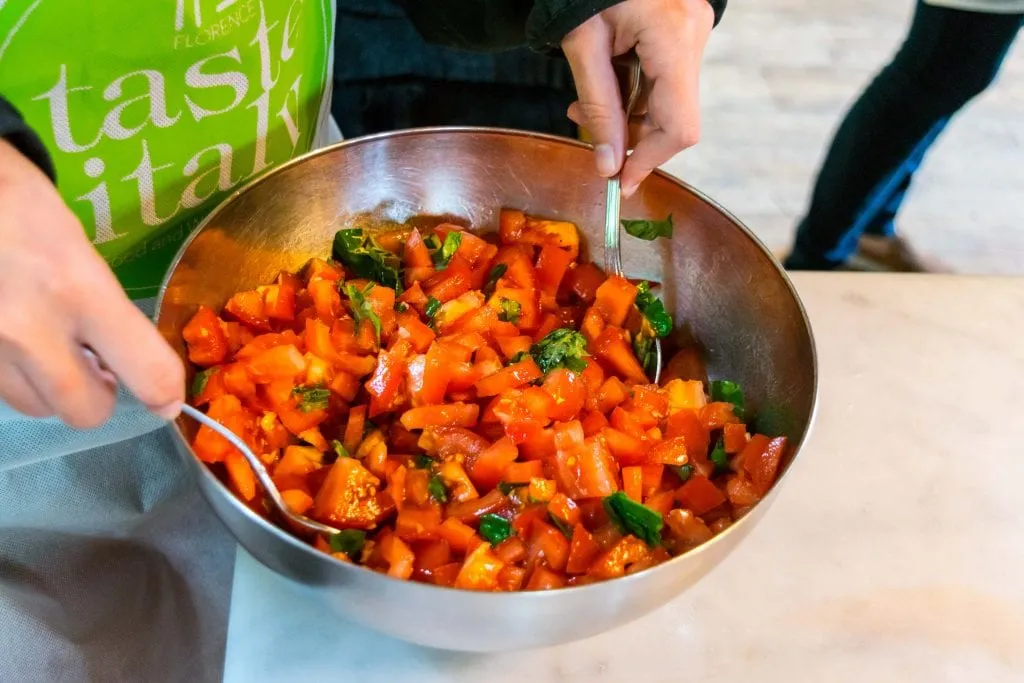
Ribollita
Traditionally made of leftovers, ribollita is a hearty stew-like dish that starts with leftover bread and cannellini beans.
From there, chefs can add cabbage, lacinato (sometimes referred to simply as Tuscan kale outside of Italy), and, like so many use-it-up stews around the world, whatever other assortment of vegetables that happen to be on hand.
It’s tasty, simple, and filling, and is one of the best things to eat in Florence.
I often catch myself ordering it after several days in Tuscany, when I’m ready for a lighter dinner!
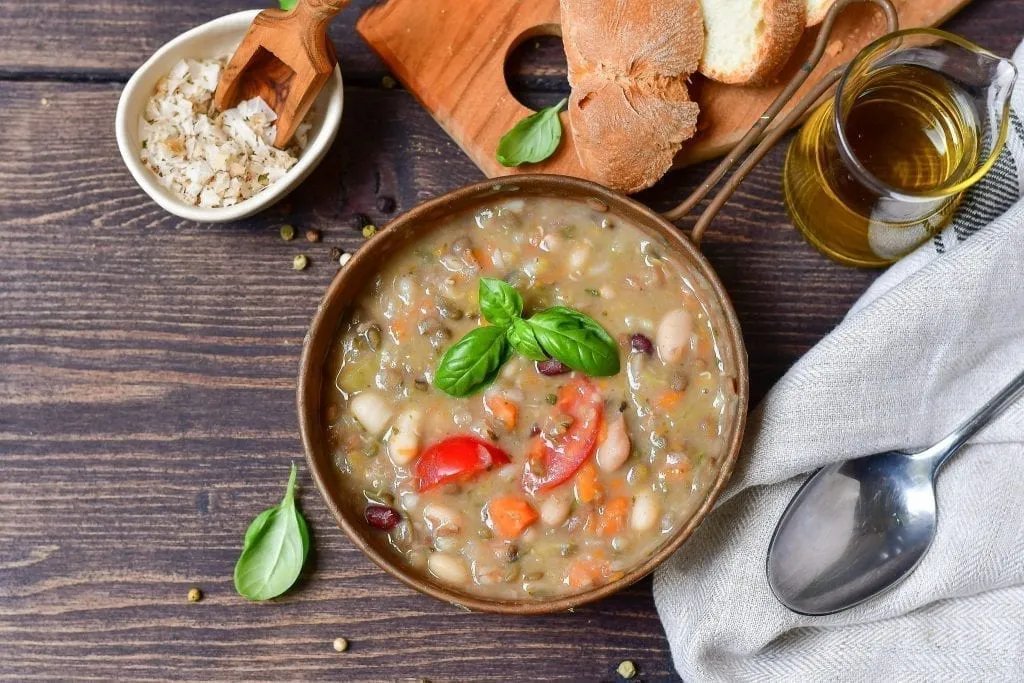
Truffles
One of the most expensive foods per weight in the world, both black and white truffles grow in abundance in Tuscany, making Florence one of the best places to eat them–on pasta, on bread, cooked into truffle oil… the possibilities are endless.
They say that truffles carry such a specific taste that you either love them or hate them at the first bite.
For Jeremy and me, it was definitely love at first taste, and they’re our first response whenever we’re trying to decide what to eat in Florence on a beautiful fall afternoon.
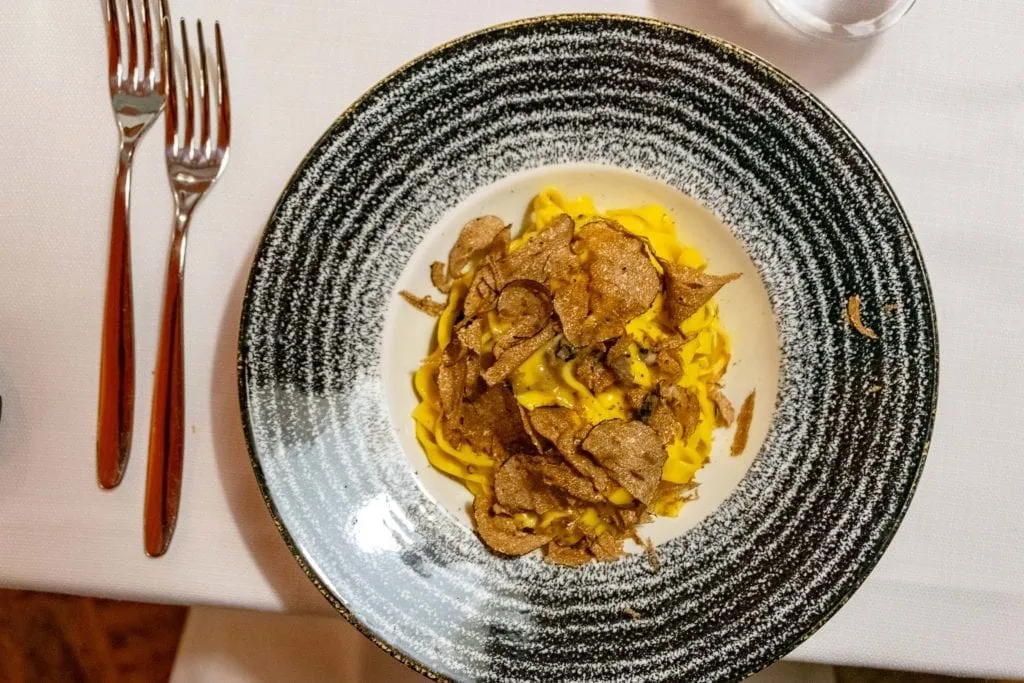
Pappa al Pomodoro
Tomato soup made with old bread that is soaked in the tomatoes until it is soggy–sound a little gross?
You’d think so, but no!
Pappa al pomodoro is a Tuscan specialty, and it is absolutely delicious.
Every recipe we’ve tried has been a little different, ranging from very liquidy with chunks of bread in it to so thick that it is almost a paste, but they are all tasty.
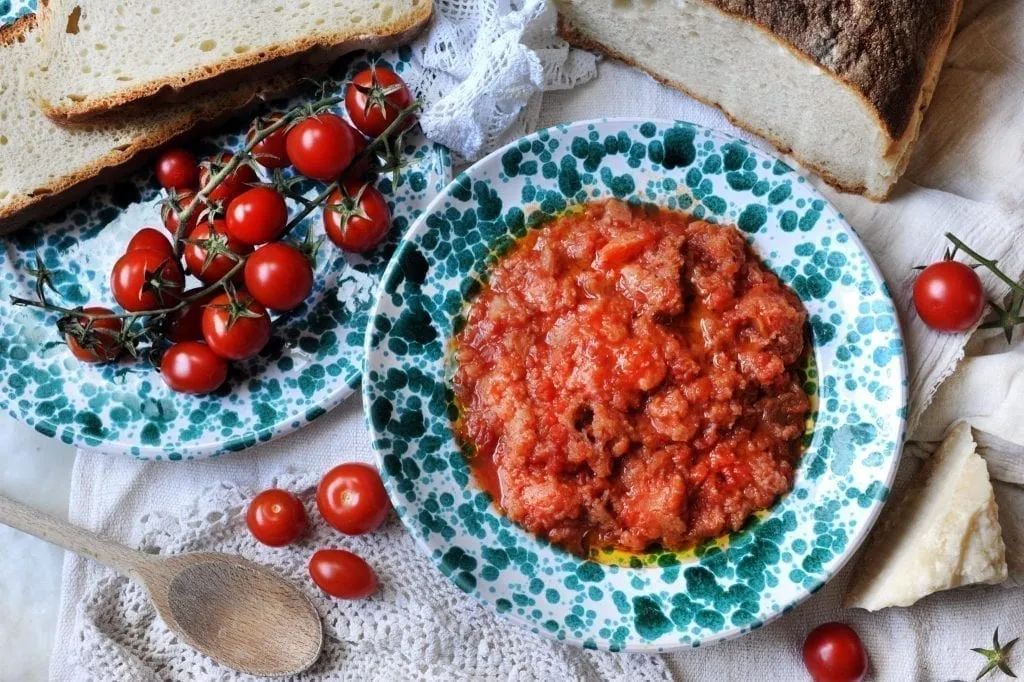
Fresh Pasta
Though clearly traditional to Italy as a whole and not just to Florence, the idea of not adding pasta to your list of things to eat in Florence is a thought that shouldn’t even be entertained.
It’s absolutely delectable, and comes in all shapes and sizes (to be paired with specific sauces: in Italy, pasta shape and sauce are paired together with intention).
Try a pasta cooking experience to learn the secrets of pasta making to recreate at home (it’s very doable once you get the hang of it).
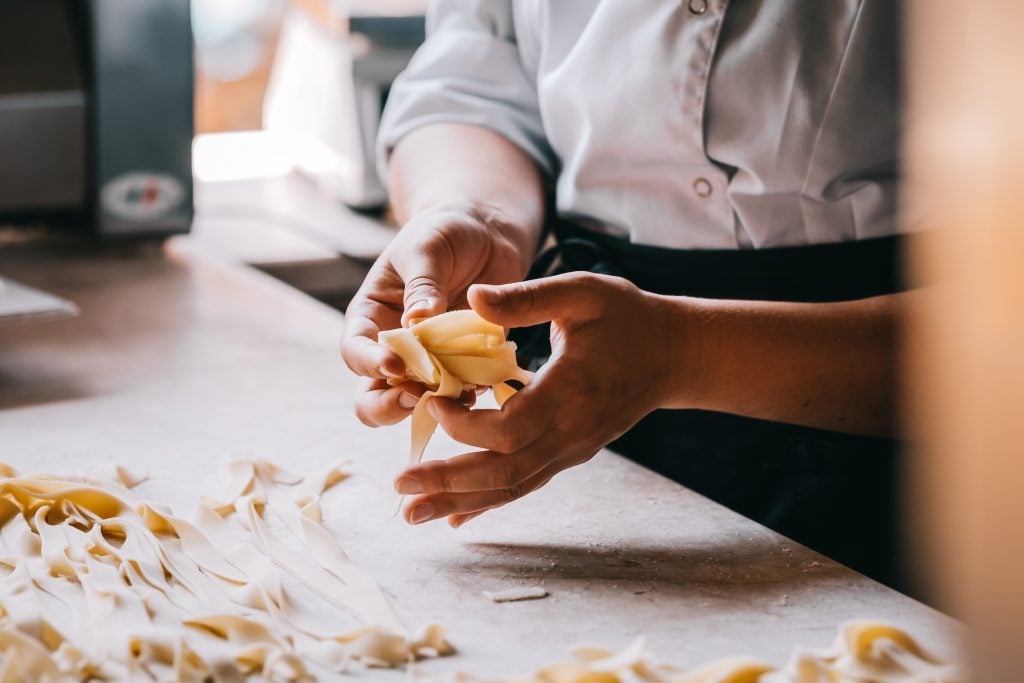
Wild Boar Ragu
A hearty tomato-and-meat sauce, or ragu, is iconic across Italy–and versions of it (like Emilia-Romagna’s bolognese) are among the most famous Italian foods across the globe.
In Tuscany, a ragu is traditionally made with wild boar meat, and it is delicious.
You’ll often see it served with pappardelle (wide, flat noodles perfect for scooping up hearty sauce), like this:
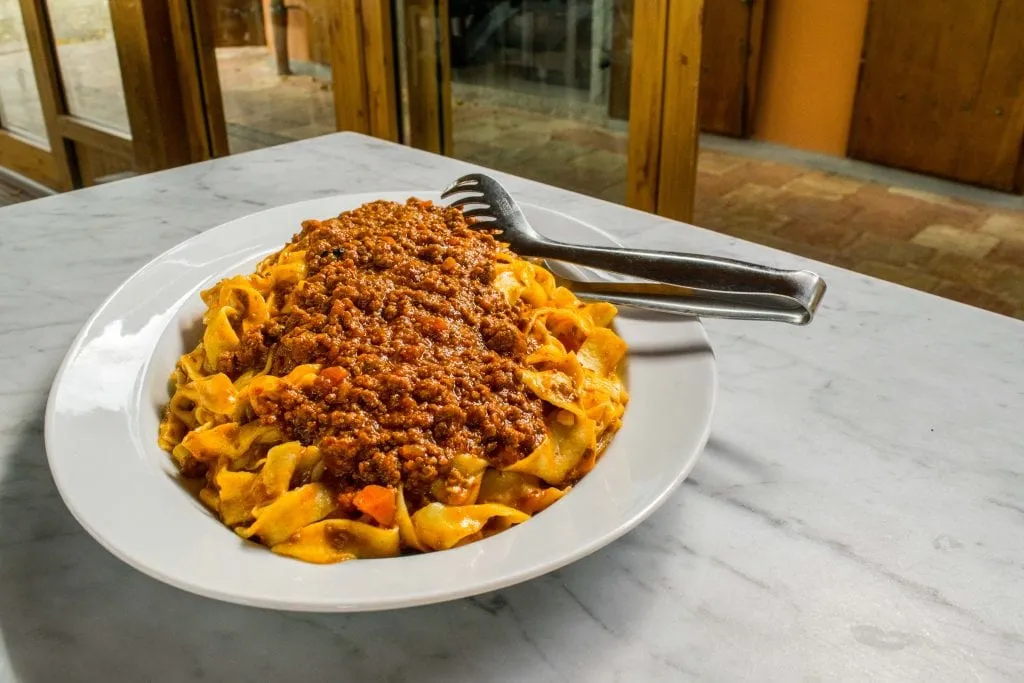
Panzanella
Tuscans are experts at using up leftover bread, and panzanella is another great example!
Made with tomatoes, cucumbers, olive oil, spices, and–of course–stale bread that has been softened, panzanella is a cold bread salad that is traditionally served during the hot summer months.
Coccoli
Soft, fried dough served with soft cheese and cured meat is a classic dish across Italy, but every destination tends to have its own specific combination, and coccoli is Florence’s.
The soft balls of fried bread–think savory donut–are generally served with a pile of stracchino and prosciutto, and the result is an excellent appetizer that’s hard to stop eating once you start!

Chianti Classico
Tuscany is possibly the most famous wine region in the entire world (though the French may argue that), so it comes as no surprise that there are oodles of different types of wine being created in the region–but none are quite so classic (forgive the pun) as the Chianti Classico.
Spicy, dark, and delicious, we have yet to meet a bottle of this wine that we don’t like.
Defined as containing at least 80% Sangiovese grapes grown in the Chianti region and recognized by its rooster seal, Chianti Classico’s are hard to resist and have become one of our favorite wines (even if I do get the urge to quote Hannibal Lector each time I open a bottle, an unfortunate by unavoidable association).
A Chianti wineries tour is a great way to discover this local wine followed by tastings and dinner, but you don’t have to leave the city to enjoy it: any restaurant, enoteca, or even grocery store will carry gobs of it.
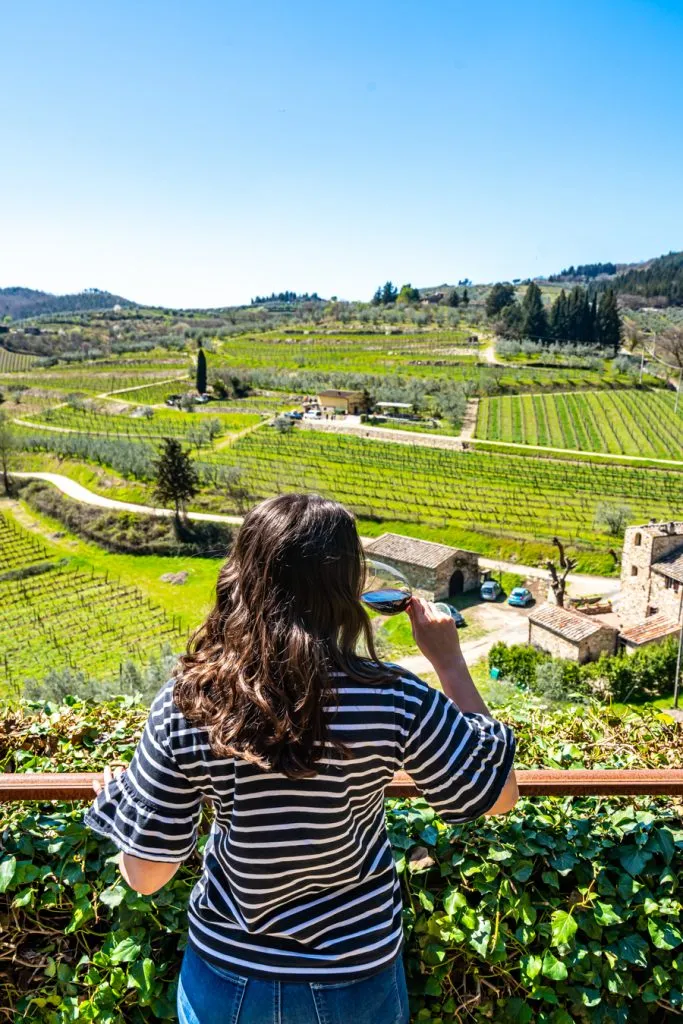
More Tuscan Wine
Delicious Tuscan wines don’t stop at Chianti Classico, though, so be sure to explore wine in Florence beyond its most famous variety!
Super Tuscans, vin santo (dessert wine), Vino Nobile di Montepulciano, and Brunello di Montalcino are just a few other world-class Tuscan wines that are easy to get your hands on in Florence and deserve to be sampled while there.
While Tuscan wine is famous worldwide for good reason, it’s arguably never tastier–and certainly never more affordable–than when it’s enjoyed right in its homeland.
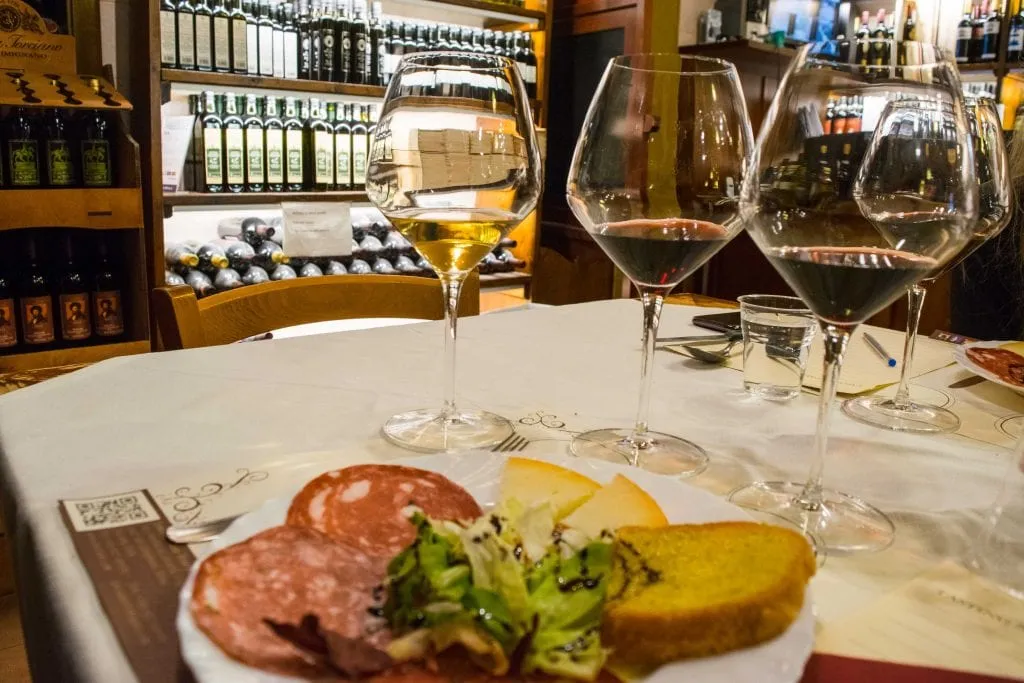
Panini
A delicious panino is one of my personal favorite things to eat in Florence.
Made of Tuscan bread and stuffed with a combination of local meats and cheeses, a panino served with a glass of wine is a simple and unforgettable lunch.
There are many famous panini shops in Florence (All’Antico Vinaio has transformed itself into a global chain in the years we’ve been visiting Florence), but while they’ve all been delicious, we don’t think any of them are worth the lines.
Personally, we like Il Panino del Chianti and Il Cernacchio and tend to visit the later on almost all of our trips to Florence.
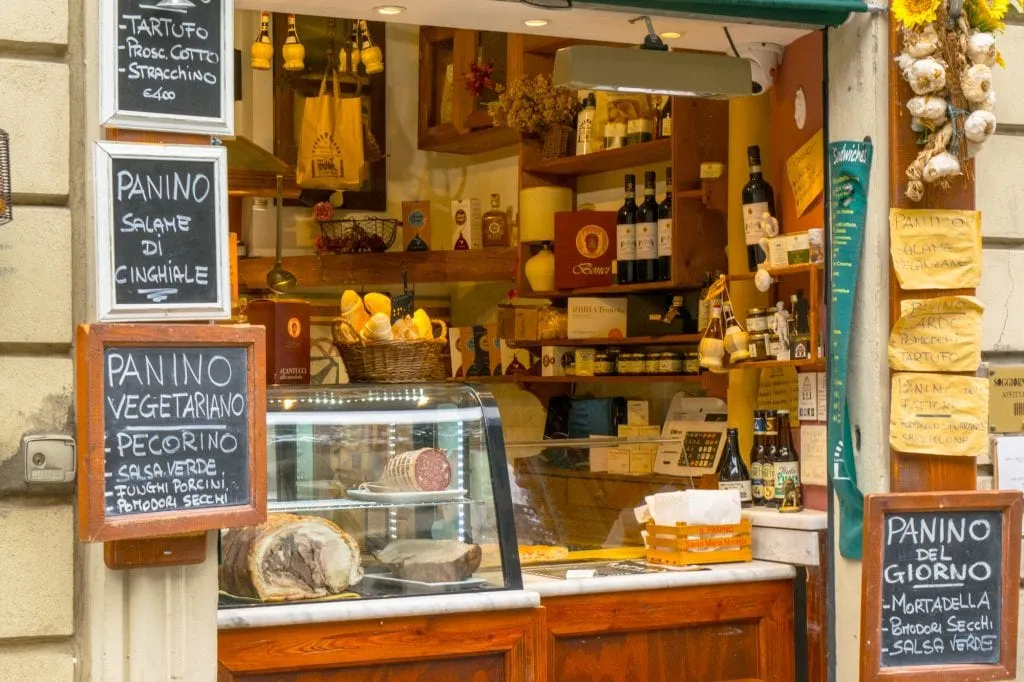
Lampredotto
Like the idea of enjoying a panino but want to step a bit further outside your comfortable zone to enjoy one of the most traditional things to eat in Florence?
Lampredotto is made with the abomasum, or fourth stomach of a cow, and it’s an iconic (if not terribly popular with tourists) food in Florence.
Crostini
Crostini is a typical Tuscan appetizer that is similar to bruschetta, but has key differences (the bread is toasted, and the slices generally thinner and smaller).
It’s a great option if you’re trying to decide what to eat in Florence and hope to expand your palette a bit!
The most traditional topping in Tuscany is chicken-liver pate, but most crostini platters come with a few different pates, including some that are a bit less adventurous, like olive pate.
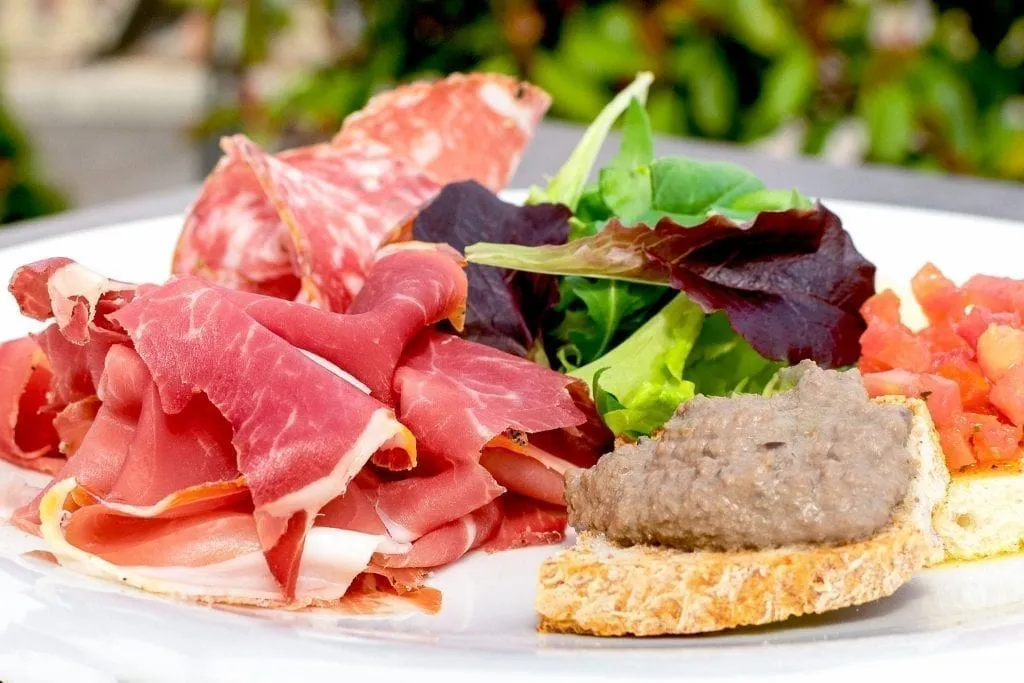
Gelato
There’s a bit of a debate about the origins of gelato, but the dessert is most commonly attributed to being created by a Florentine, and there’s nothing quite like enjoying a dessert that is famous worldwide while strolling around the city it was created in.
If you’re looking for a gelateria with homemade gelato instead of gelato produced off-site, the typical advice is to avoid the tempting displays of enormous gelato mounds and aim for a shop that keeps their gelato in the classic silver cans or tubs–anything that ensures the gelato is surrounded by metal.
You’ll also want to look for muted colors: if the pistachio is bright green instead of a dull brownish-green, that’s a red flag.
There is a wide variety of truly delicious gelato in Florence (and even more mass-produced gelato aimed at tourists), but our go-to spots are generally Gelateria Edoardo by the Duomo, My Sugar near the Galleria dell’Accademia, and Gelateria della Passera in Santo Spirito.
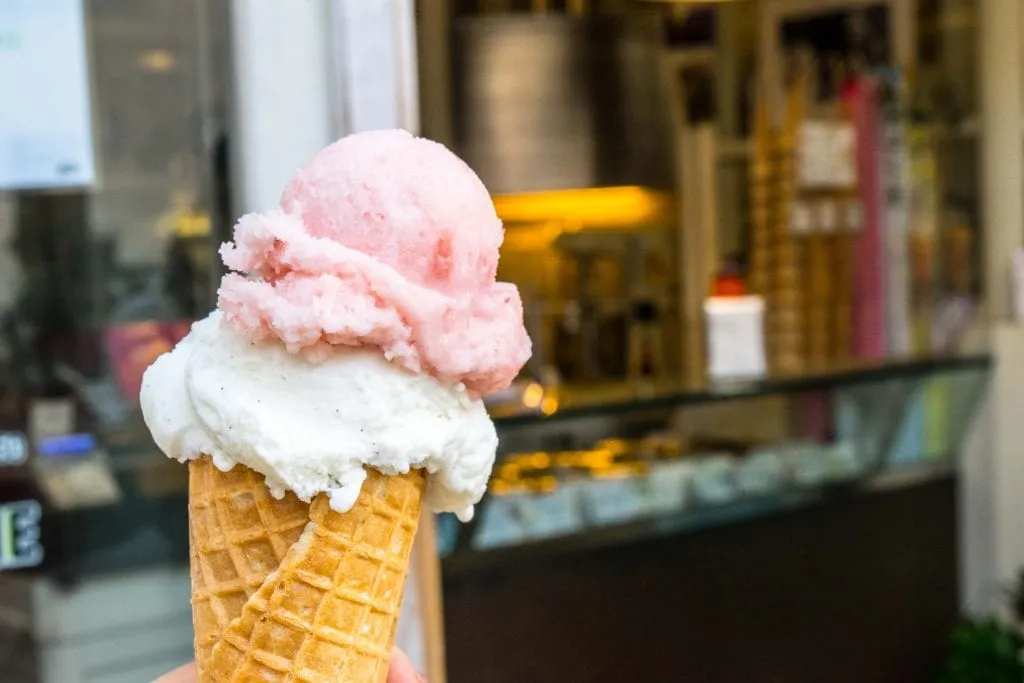
Cantucci
These crisp almond biscuits remind me of what we think of as biscotti in the USA, but the secret to enjoying them is all Tuscany!
Served as a dessert, cantucci cookies are dipped into sweet wine (traditionally Vin Santo) and eaten once the wine has soaked into the cookies, softening them.
The resulting taste is fantastic, but they also come with a tradition!
According to our guide during a wine tasting at Tenuta Torciano, cantucci also have a flirting ritual behind them, which our host shamelessly had Jeremy and I (several glasses of wine into the meal at this point) act out!
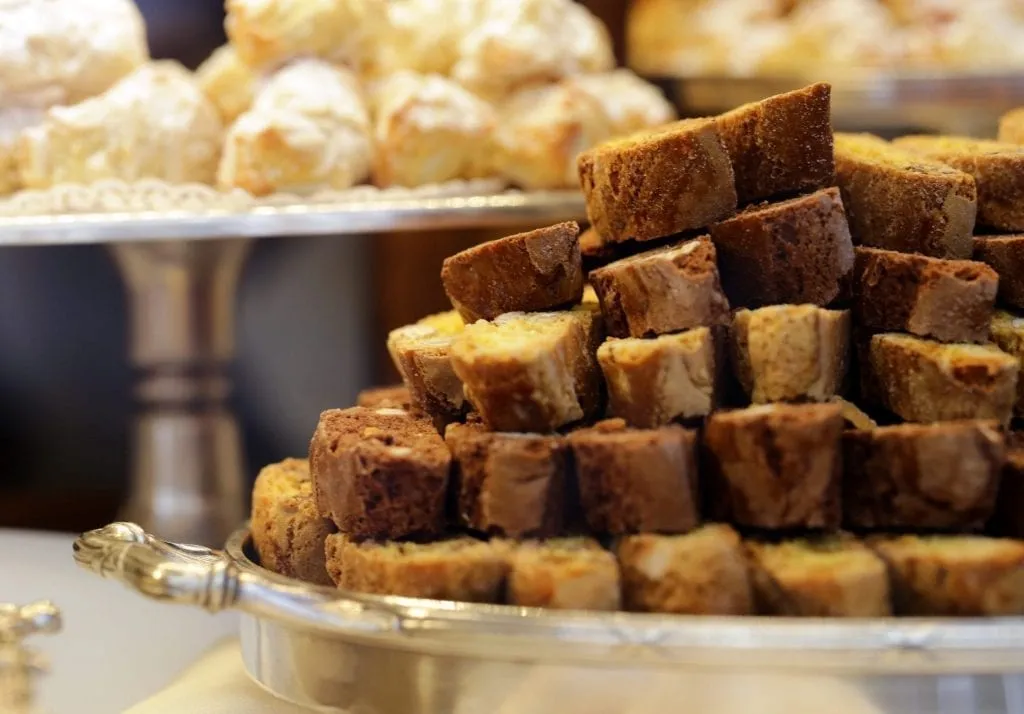
Types of Restaurants in Florence
In addition to bars (which act as both coffee shops and what we consider a typical bar in the USA), panino shops (casual sandwich shops), and cafes, you’ll find three distinctly different types of places to eat when exploring the food in Florence.
Keep in mind that in the modern age, especially when in touristy areas, these names don’t necessarily mean what they should mean–in modern Florence, you’ll find them used more to add flair to the name of an establishment rather than as a literal description–but they are an interesting piece of Italian culture and worth keeping in mind when exploring Florentine cuisine.
Here they are–in order of formality.
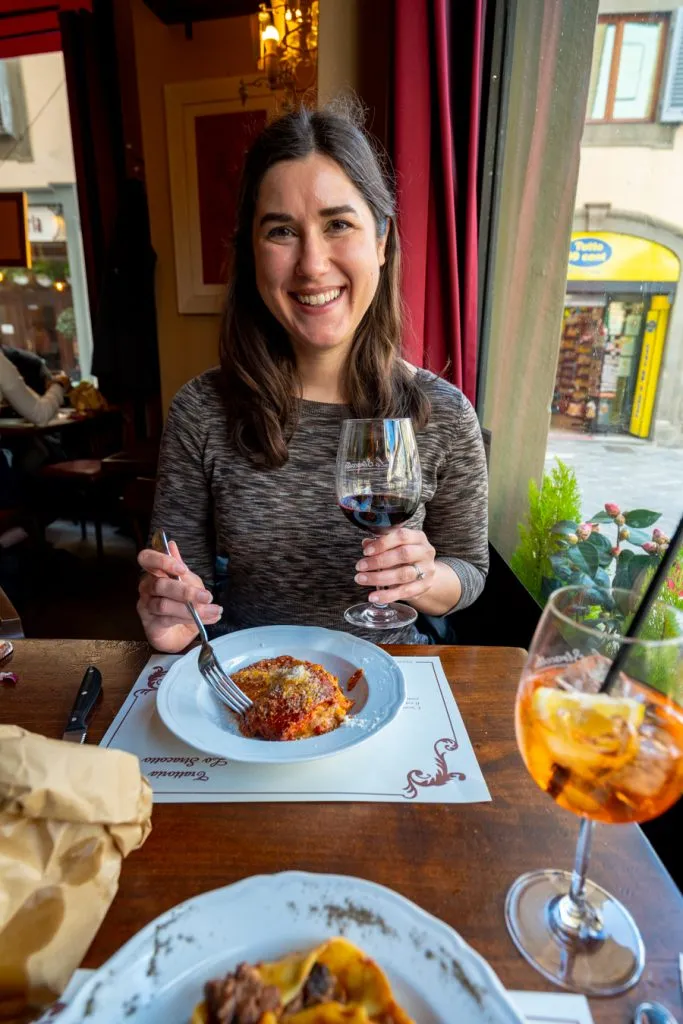
Ristorante
Ristorantes are typical restaurants and are considered to be a bit more formal than the other establishments listed here.
These will typically have the highest price point and the largest menus.
Trattoria
Trattorias are more casual and local than ristorantes, and generally serve hearty, unpretentious food in a casual, laid-back atmosphere.
You can expect larger portions than in a ristorante, but generally fewer choices (not that you’ll need more choices, as everything is delicious).
Menus will change regularly here, and in the best places, often even be handwritten!

Osteria
Osterias are traditionally extremely informal, with low prices, limited menu choice, and a very casual atmosphere.
Menus will shift regularly.
Traditionally, osterie were found mostly in the countryside.
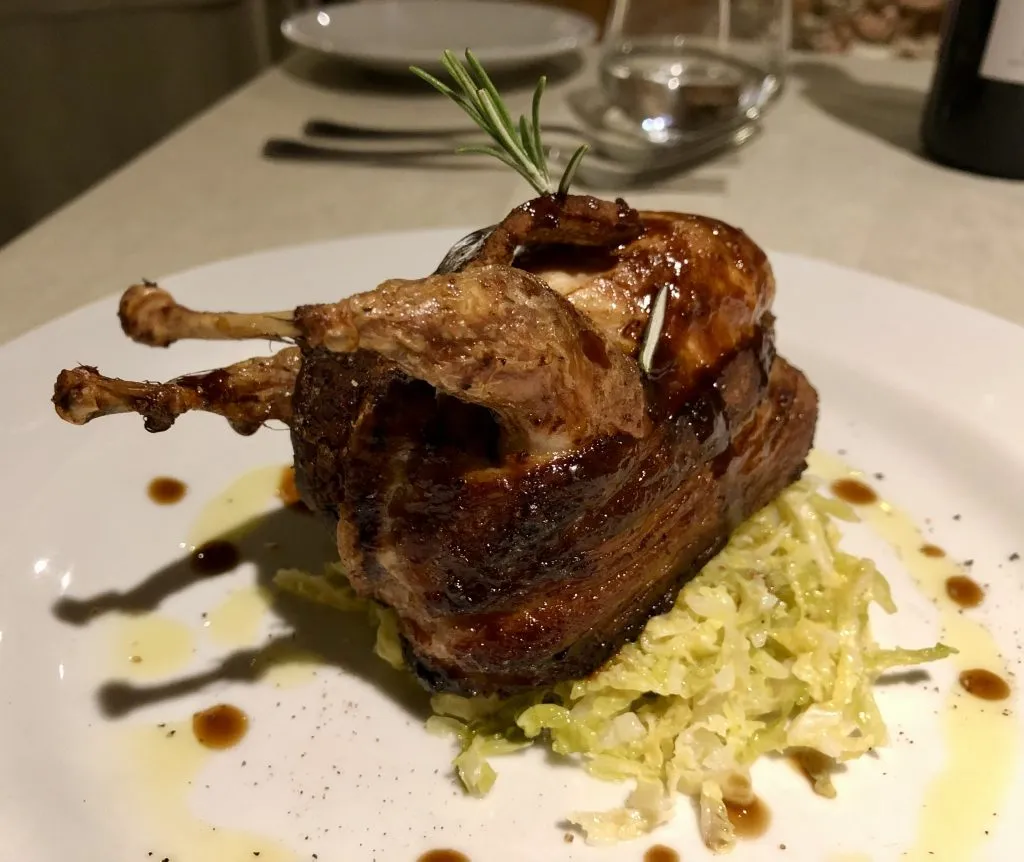
Cool Experiences With Food in Florence
Have breakfast the Italian way.
What’s even better than drinking a cappuccino in the morning?
Participating in the Italian ritual for doing so!
Rather than sit at a leisurely cafe, head to a bar (aka coffee shop in American-speak) and order a cappuccino and possibly a pastry of your choice to enjoy while standing at the marble counter.
Once you’re finished, head over to the cash register and pay.
Voila! You’ve not only had a fun-and-easy cultural experience with breakfast, you’ve saved some money, too–coffee is generally more expensive in Italy if you drink it at the table, rather than standing at the bar.
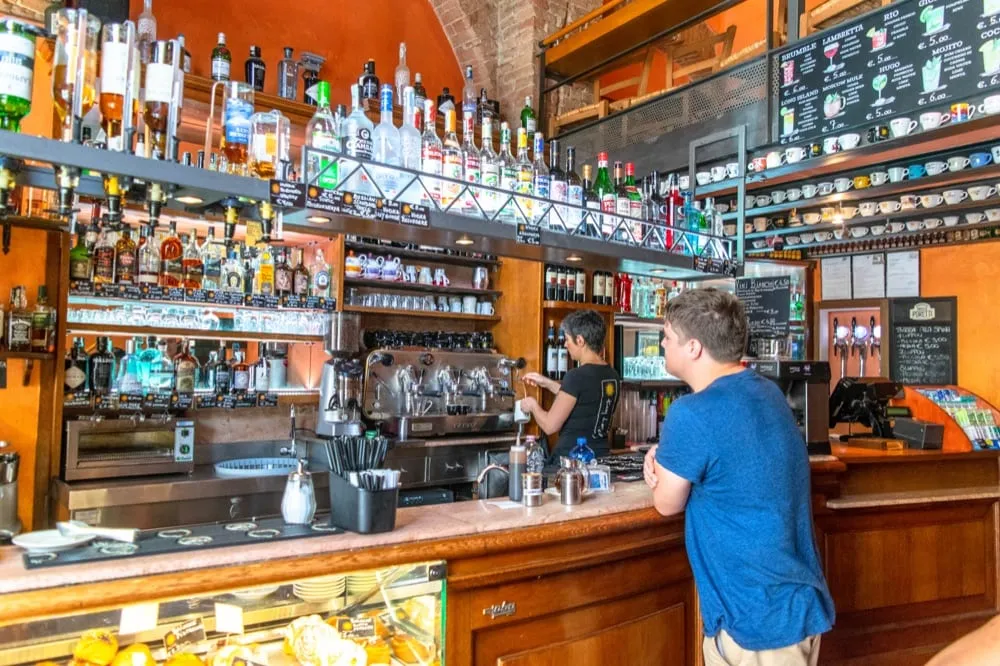
Take a Tuscan cooking class.
We were hosted by Walkabout for an absolutely amazing cooking class in the hills of Tuscany, and we can safely say that it is an experience we will never forget.
Not only was the view incredible (seriously, a farmhouse overlooking Tuscan countryside with a glass wall to best appreciate the view–swoon), but we worked our way through an impressive menu.
Through the course of the day, we made (and devoured) bruschetta, handmade pizza, roast pork loin and potatoes, tiramisu, and handmade pasta with a homemade Tuscan sauce that we oversaw from beginning to end.
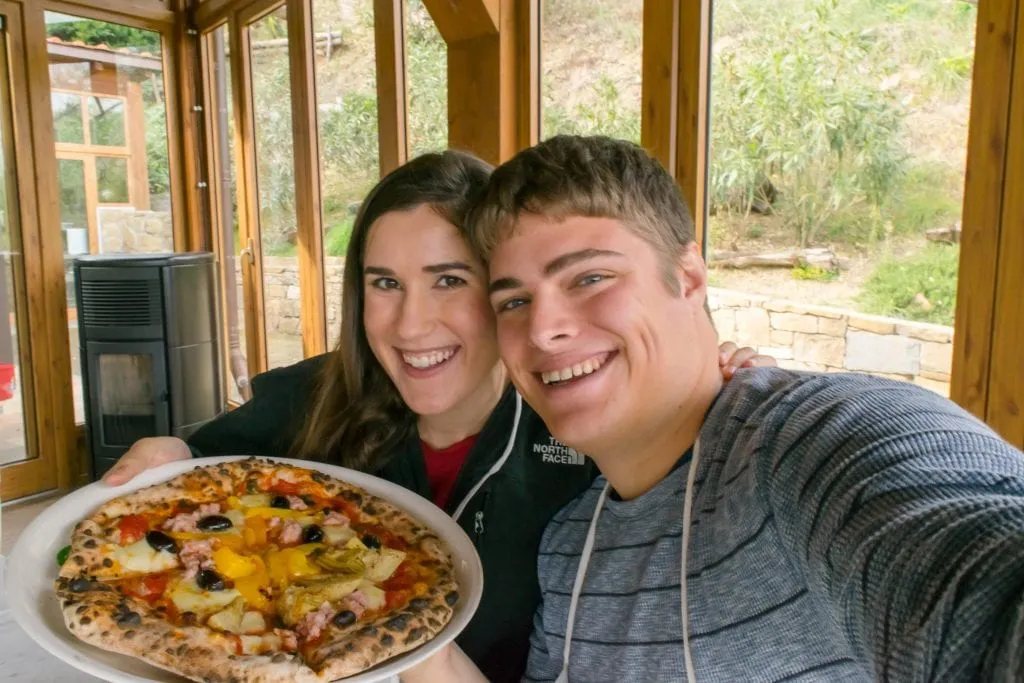
The chef, Isaac, made the perfect leader for coaching us through the traditional Tuscan tricks for getting, as he put it, “the most flavor out of the least work” (a cooking philosophy we can solidly get behind).
It’s always hard to know how much “learning” will actually take place at a tourist-style cooking class, but in between generous helpings of Chianti Classico we picked up some tips and tricks that have improved our cooking in the years since.
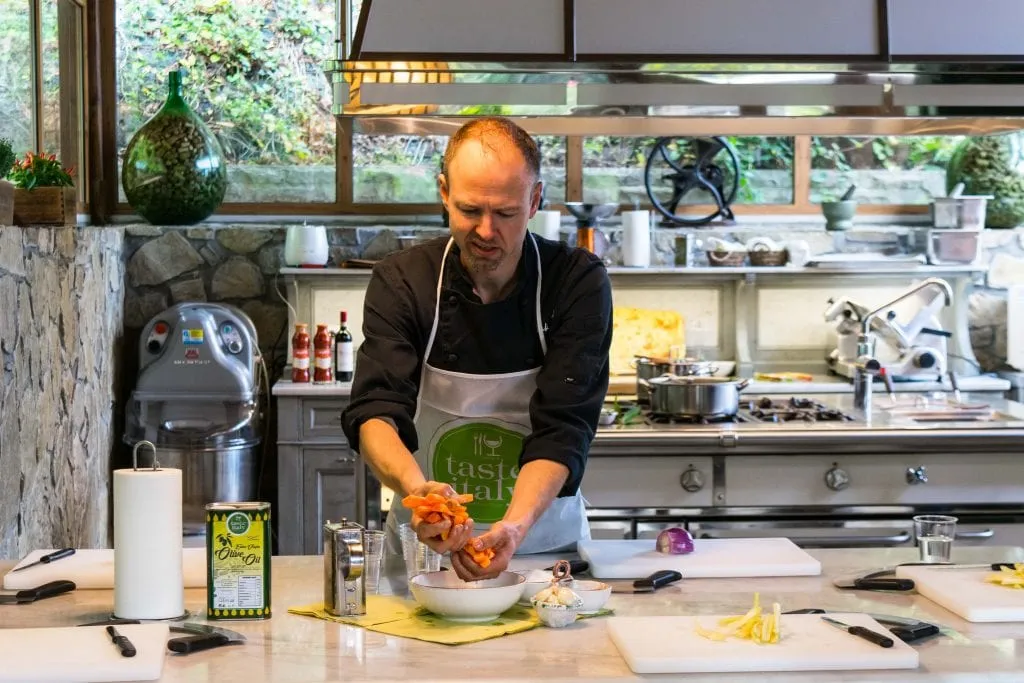
Shop at the Mercato Centrale or Mercato Sant’Ambrogio.
Looking for fresh cuts of meat, fruit, cheese, wine, spices, pasta, balsamic vinegar, olive oil, a plated-and-served meal, or about fifty thousand other food-related things?
Head to Mercato Centrale or Mercato Sant’Ambrogio!
Both markets are located in Florence’s historic center, and popular to visit–but Mercato Centrale is undoubtedly the larger, busier, and most “touristy” of the two.
Mercato Sant’Ambrogio is a wonderfully quiet change of pace, but at the end of the day, both markets offer similar experiences: traditional Tuscan food available in ingredient form from many stalls, and offered as prepared dishes at on-site eateries that are more casual and generally less expensive than going to a separate restaurant.
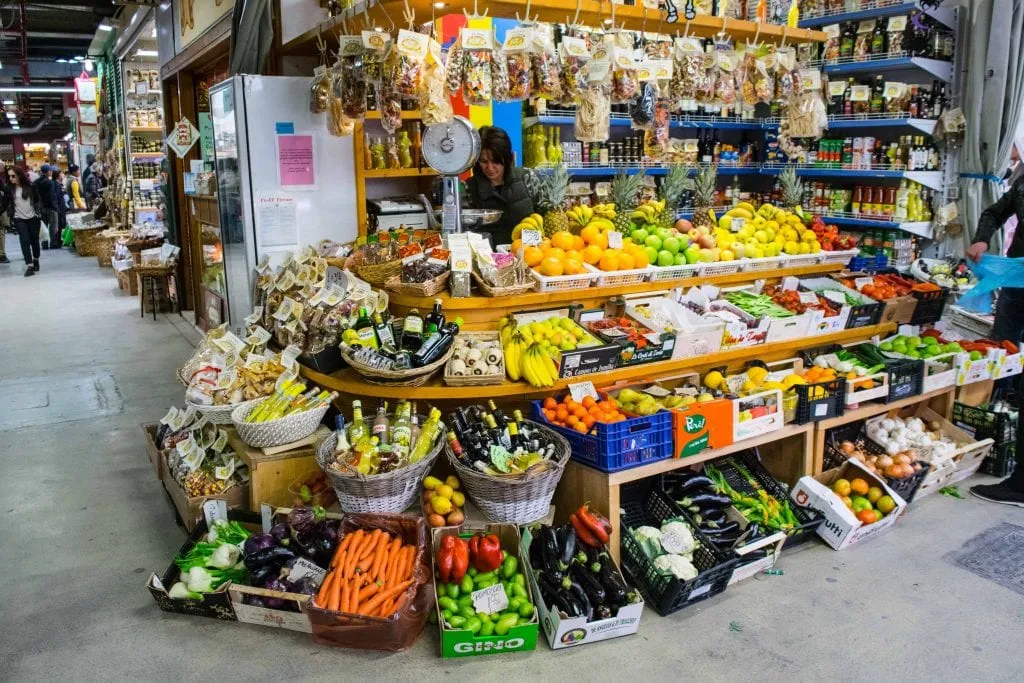
Take a walking tour of the food in Florence.
We were generously hosted by Walks (one of our favorite tour companies in Italy and one we pay for tours on during most trips to the boot) on their evening Florence food tour and we had an incredible time!
Our charming guide, Julia, made sure that we left even more enchanted with food in Florence than we were when we arrived (which is an impressive feat considering how much we loved it when we started).
It helped that she lived in the Santo Spirito neighborhood our tour focused on–she was a wealth of information both at our stops and between them.

The tour consisted of four official stops (plus one bonus stop Julia made toward the beginning of the tour to show us an uncrowded and gorgeous view of the Ponte Vecchio), all special in their own way.
Stops included a visit to a meat-and-cheese store for salami, cheese, Tuscan bread, and wine, a stop at an enoteca (wine shop) for a tour of the most interesting wine cellar we’ve ever seen and tastings of oils and spreads, a dinner including the famous bistecca all fiorentina, and, of course, we finished with a stop for gelato.
In other words, the “walking” part of the walking food tour of Florence wasn’t so much a design choice but a physical necessity!
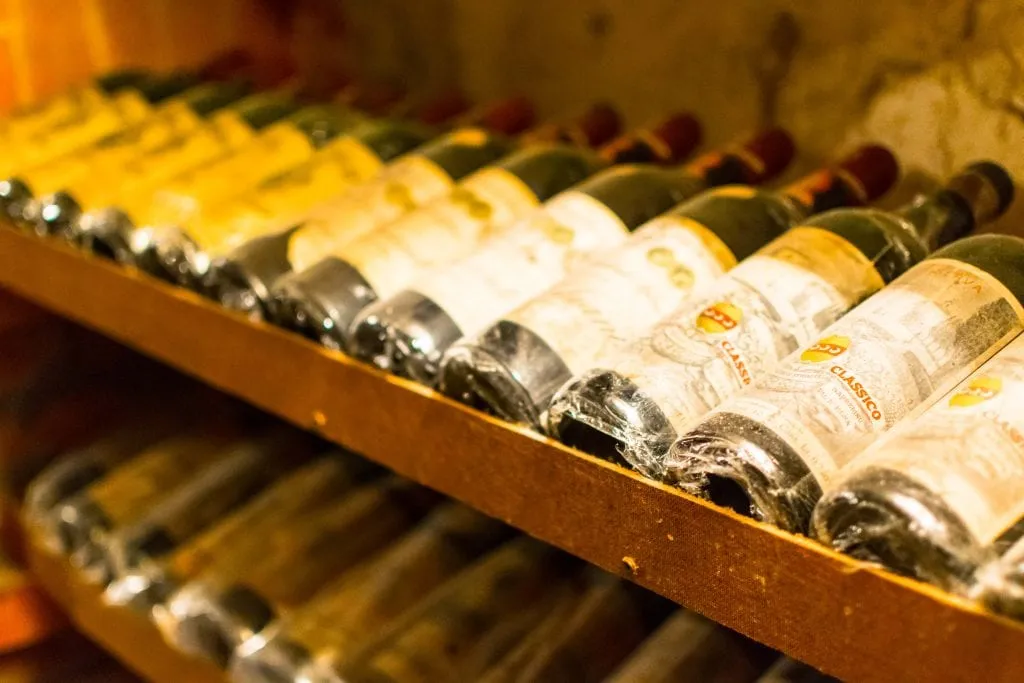
Have lunch at a panino shop.
Florence’s cozy panino shops are one of our favorite places to grab a quick bite to eat in Florence for lunch.
Generally, one sandwich is more than enough for a lunch, and stopping here is much faster than sitting down at a trattoria (and as delicious as sit-down meals are, doing it twice a day for the length of a trip to Italy can eat up both a lot of sightseeing time and stomach space).
For best results, wash it down with a glass of Tuscan wine!
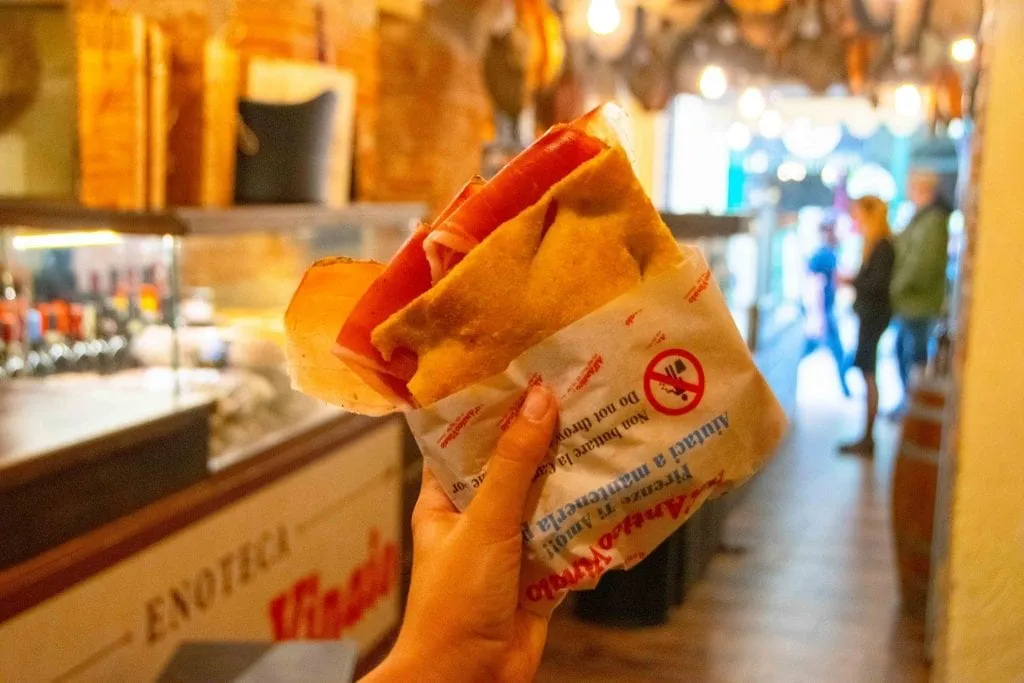
Settle in for a complete, multi-course Italian meal.
Whether you do it on a tour, at an upscale restaurant on a special night, or simply for a casual lunch out, while experiencing food in Florence be sure to set aside the time (and by time, I mean multiple hours) at least once to work your way through the four traditional Italian courses in a single sitting.
The traditional courses to enjoy in Italy include antipasto (appetizer), primo piatto (this is where you’ll usually find pasta dishes, though it can be other things), secondo piatto (the meat course), and dolce (dessert).
Even then, it’s not over–coffee traditionally comes after the dolce course, and an amaro (a bitter shot, such as grappa, to aid digestion) may follow the meal.
If all of that still isn’t enough food, you can order a cortorno, or side dish, with your secondo piatto, which is usually a much-needed dose of vegetables.
If you’re feeling like a financial splurge, go to a nicer restaurant and have each course paired with a specific wine–you may have to roll yourself home after all that food and wine, but it’s definitely a food experience in Florence that you won’t forget.
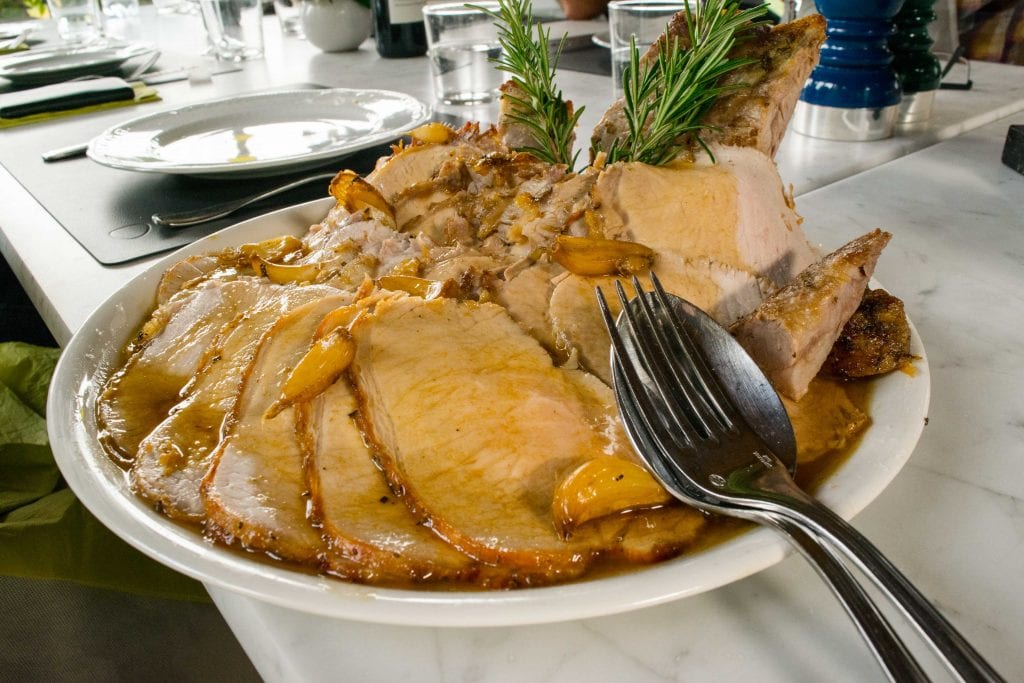
Discover Florence’s wine windows.
Dating back to the 17th century, the wine windows (or buchette del vino) of Florence are a very old tradition that has fond new life over the last several years.
Wine windows are essentially a contactless way to sell wine by the glass, Renaissance-era style, that began as a way for nobles to sell their product without having to open an official shop.
Like so many business decisions over the centuries, this is said to have gotten its start primarily as a way to avoid taxes.
Fast forward to 2020 and beyond, and a combination of social media and a suddenly reinvigorated demand for a contact-free way to purchase wine made wine windows popular once again.
Here’s where to find active wine windows in Florence today!

Experience wine tasting in Tuscany at a local winery.
Wine tasting in Tuscany–of all the people in the world who have travel bucket lists, I’d say that this is an experience that pops up on an enormous number of them!
Tuscany is one of the most popular destinations for wineries in Italy, and with good reason!
If you’re going to do it, though… do it right.
We loved this wine tasting (plus a visit to San Gimignano!) that we enjoyed as part of our day hosted by Fun in Tuscany.
After visiting the adorable town of San Gimignano, we headed to Tenuta Torciano winery for one of the most delicious and memorable wine tastings that we have ever had.
(And as of the time I’m updating this blog post in December 2024, it has been some years and many trips to Florence since that day, and I stand by that statement! We’d go back in a heartbeat.)
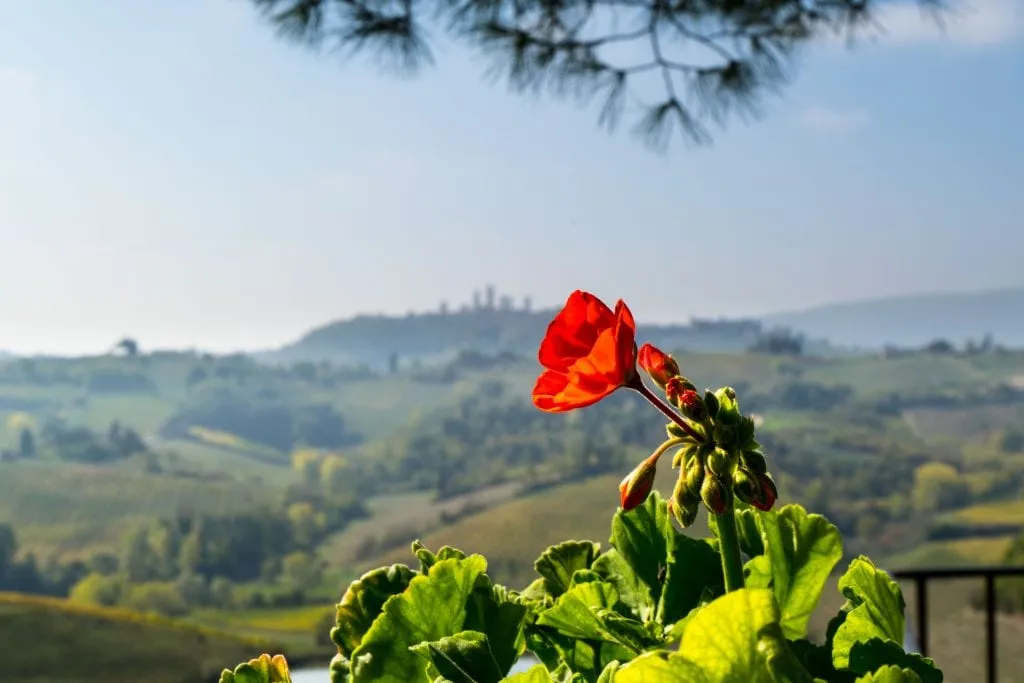
Before we even sat down at the table, the property itself already made sure we would remember it: the winery is home to several of the most interesting-looking chickens we have ever seen, one of which our tour guide put on my head!
The meal with wine, though, was definitely the highlight of our visit.
Together with our small tour group (just eight people!), we worked our way through eight wines.
We also tried some amazing 30-year-aged balsamic vinegar, some tasty olive oil, and tasted truffle oil for the first time in our lives–it was served over one of the best lasagnas we have ever eaten, and Jeremy and I are still talking about that dish years later!
With all that alcohol, we definitely needed the food: in addition to the lasagna, we had a salami and cheese plate each, a salad (with balsamic vinegar, of course), and some cantucci cookies.
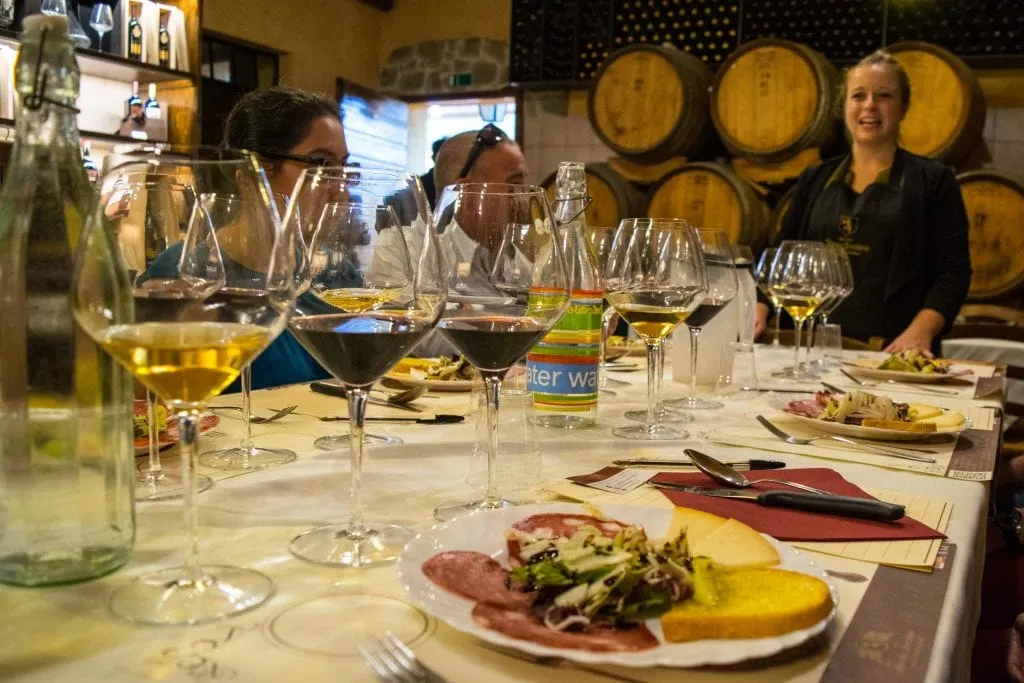
Read More About Food Culture in Italy
If you found this blog post about what to eat in Florence helpful, we’d love to help you keep planning your trip to Italy here on Our Escape Clause!
We’ve spent more than a cumulative year each traveling in Italy at this point, and we’ve learned a lot along the way.
You can browse our 100+ Italy blog posts here, or check out these guides:
- Learn what an Italian coperto is, and why you should be aware of it in restaurants.
- Get the details on everything you need to know when dining out in Italy.
- Browse our recommendations for how to spend 2 days in Florence.
- Learn what to expect from a pizzeria in Italy.
- Get our suggestions for optimizing 3 days in Tuscany.
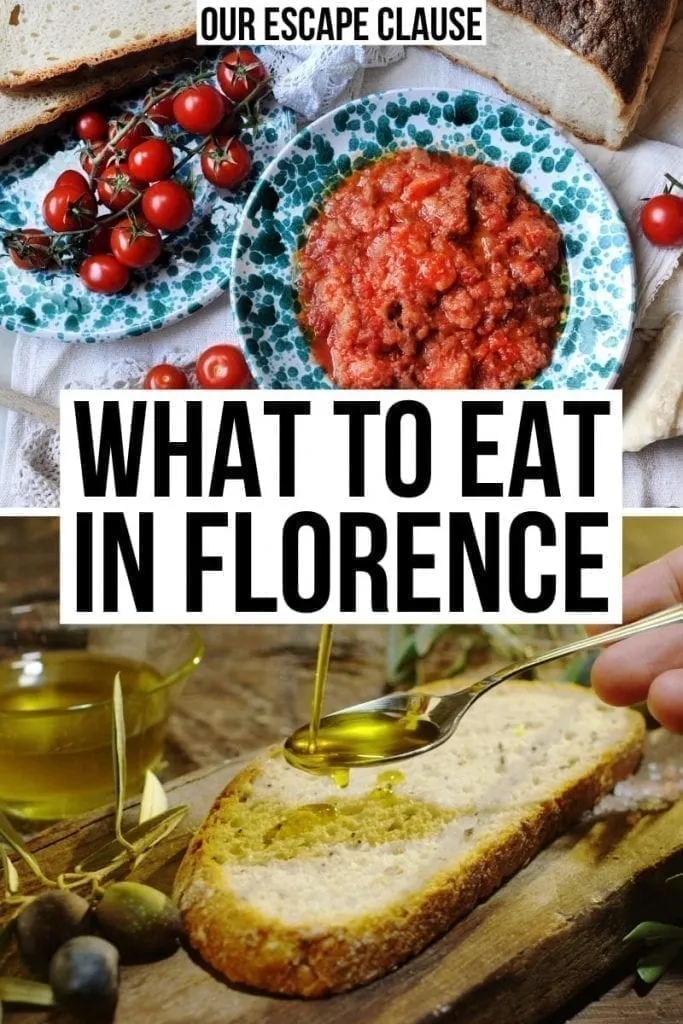
Many thanks to our partners for hosting us on some of our food experiences in Tuscany: Fun in Tuscany for our wine-tasting experience as part of our day out with them, Walks of Italy for taking us on our Dine Around Florence walking tour, and Walkabout Florence for hosting us on a cooking class in Tuscany at their farmhouse in the hills surrounding Florence. All opinions are, as always, our own.
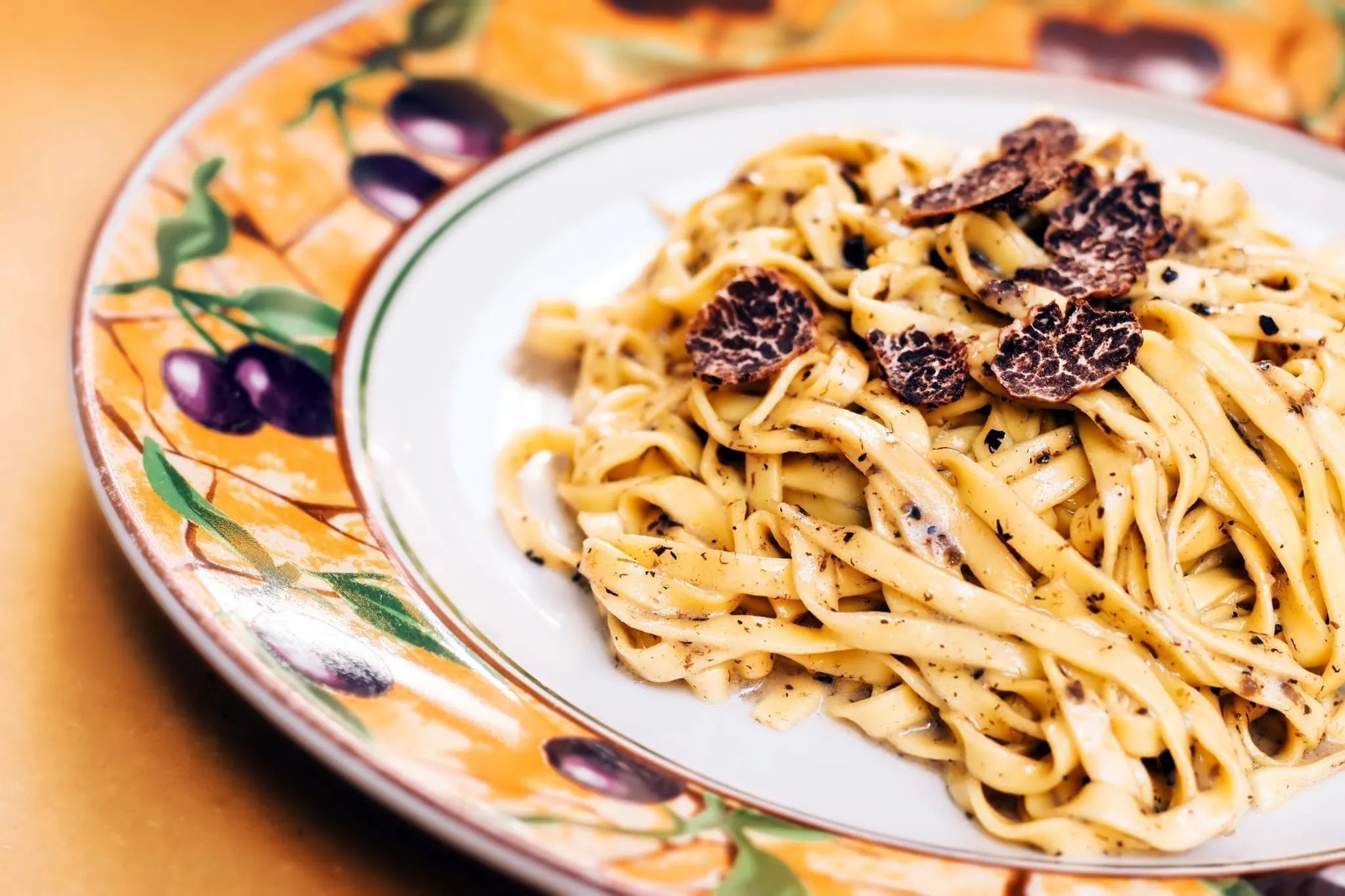
Olive oil tastings are one of my favorite things to do! Everyone thinks it’s weird, but it’s so interesting and fun! And it’s not nearly as gross as everyone makes it out to be. I would love to do an olive oil tasting through Italy in conjunction with a wine and bread tour. Now THAT’S got my tummy rumbling!
Hey, I don’t think that sounds weird–sounds absolutely sublime to Jeremy and me! If you get the chance to come, definitely try to time your visit for the olive harvest in the fall. Perfectly fresh olive oil has ruined me for normal bottles in the grocery store!
I will visit Florence in a couple of weeks so it’s good to see the food there is delicious. As I eat alone I think I’ll go to the gym before I attempt a Florentine Steak. That way I’ll get maximum benefit from the dish! The pasta must be delicious too!
Oh, I hope you love Florence as much as we do! You’ll need a BIG workout to have a chance at eating a whole Florentine steak yourself–good luck! Lol.
I’m planning a trip to Italy and Florence is high up on list, although not for a month but for a much shorter duration. Being a vegetarian I usually struggle with food in Europe, but you’ve provided me with an amazing list of food items which I can relish without actually hunting for vegan food 🙂 Bookmarking your post for my future travel, I’m sure it’s going to be useful for me 🙂
Definitely plenty of vegetarian options around here! One of the girls in our cooking class was a vegetarian, and she didn’t have any issues. 🙂 Hope you love your Italy trip!
Florence sounds like foodie heaven! I’m sure it’s one of the best places to have the freshest Italian food. I love your food photos. They make my mouth water!
It really is foodie heaven! Perfect way to describe it.
You had me at Bistecca alla Fiorentina! I’m in Italy often so go frequently for these meal experiences. I’d like to take the Tuscan cooking class, as they have some different dishes from the north, and Sicily. A great place and post!
They definitely do–we’d love to take some classes in the north and down in Sicily now ourselves–there’s no shortage of great food spots in Italy!
Omigish, I’m so hungry now! This looks so fabulous. I’m planning to visit Florence next year so saving this post for future reference. Yum!
Oh, I hope you love it! This is just an absolutely amazing city.
Cappucino and raspberry croissant was what I had for breakfast for one day in Florence. Yes, they do make yummy pastry & coffee! I missed the walking food tour in Florence. But if I go again, I’ll definitely take it. Cookery classes may not be of my interest though.
Oooooh, raspberry croissant sounds amazing. We split a cheese danish with our cappuccino this morning for breakfast ourselves. 🙂 Cooking definitely isn’t for everyone… but eating sure is! Lol.
As a foodie, this post truly spoke to me. I am a firm believer that food is a huge part of any culture. This does not seem to be truer for any part of the world than in Italy. I love the fresh pasta, and of course, I couldn’t live without my olive oil! I really really want to try authentic Italian gelato someday too!
Oh, if you’re a foodie, you will adore Italian gelato (who wouldn’t?). It’s definitely the ultimate food destination in my book!
Beautiful and so very gastronomically tempting post. Italians really love their food and the passion they put into it shows in what they make and eat. Truffles and olive oil are a must try when in the country, and Gelato goes without saying. One thing of interest for me and something that I have not tried is the Florentine Steak, so that’s the one to go for next time.
Interesting that you say that–while we loved all of these foods, if we had to pick one that was the weak link, it would probably be the Florentine steak–but that probably has more to do with the fact that we grew up in a place that produces incredible steaks (Oklahoma) than the Florentine steak not being worth it. It was incredibly tasty!
Great list, however, please make sure that you inform your readers that Balsamic Vinegar is not a protected product of Tuscany or Florence, but rather it is a protected product from Modena, Italy (Emilia-Romagna) only. It can be purchased and tasted in all of Italy, but it can only be produced in Modena, Italy. Thank you for your nice blog!
You are correct, of course! I liked this article for learning all about balsamic vinegar. 🙂 http://www.seriouseats.com/2014/05/everything-you-need-to-know-guide-to-balsamic-vinegar.html
Awesome read! hoping to visit here next year!!
Thanks, Poppy! Glad to have you around. 🙂
Hi Kate
We are going to Florence and Bologna in October. I’ve been to Florence before so I know where I want to go, but Bologna is new. It’s apparently the food capital of Italy. Have you been there? Do you have any tips or places to visit in Bologna that concentrate on the food?
Regards
Sue
Hi Sue and Bill!
Yes, we love Bologna! We’ve visited several times over the years and spent a straight month there back in 2018. We have a few different articles on Bologna, this one is a good starting place and touches on the food: https://www.ourescapeclause.com/things-to-do-in-bologna/
We also love Parma, which is the origin of parmigiano-reggiano and parma ham and about an hour from Bologna by train. We first visited on a day trip from Bologna and then returned last year for almost a week! You might consider a day trip here as well (a parmigiano-reggiano factory tour there remains one of our most memorable food experiences in Italy): https://www.ourescapeclause.com/best-things-to-do-in-parma-italy/